
This page features the Online Library's 'What's New?' entries for January and February 2006.
For the more recent entries, and links to previous years'
entries, see:
| If you want higher resolution reproductions than the Online Library's digital images, see: How to Obtain Photographic Reproductions. |
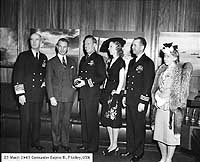 Among
the Online Library's February postings are two 19th Century Admirals
who have had, between them, six ships named in their honor, and
one of the most productive of World War II's submarine commanders.
The former pair are Vice Admiral Stephen
C. Rowan (1808-1890) and Rear Admiral Francis
A. Roe (1823-1901), both of whose careers included notable
achievements during the Civil War. The submariner is Rear Admiral
Eugene B. Fluckey,
who was awarded the Medal of Honor
and three Navy Crosses for his wartime exploits and, two decades
later, commanded the Pacific Fleet's Submarine Force.
Among
the Online Library's February postings are two 19th Century Admirals
who have had, between them, six ships named in their honor, and
one of the most productive of World War II's submarine commanders.
The former pair are Vice Admiral Stephen
C. Rowan (1808-1890) and Rear Admiral Francis
A. Roe (1823-1901), both of whose careers included notable
achievements during the Civil War. The submariner is Rear Admiral
Eugene B. Fluckey,
who was awarded the Medal of Honor
and three Navy Crosses for his wartime exploits and, two decades
later, commanded the Pacific Fleet's Submarine Force.
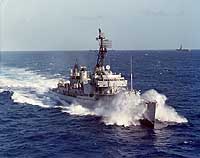 Eleven
destroyers and torpedo boats were added this month, including
five of the six ships mentioned above. They are (in chronological
order): Rowan (Torpedo
Boat # 8), Whipple
(Destroyer # 15), Roe
(Destroyer # 24), Cummings
(Destroyer # 44), Allen
(Destroyer # 66), Luce
(Destroyer # 99), Cummings
(DD-365), Rowan
(DD-405), Roe (DD-418),
Luce (DD-522) and
Rowan (DD-782).
Filling out the Navy's list of a half-dozen Rowans and
Roes is USS Rowan
(Destroyer # 64), which came on board in January.
Eleven
destroyers and torpedo boats were added this month, including
five of the six ships mentioned above. They are (in chronological
order): Rowan (Torpedo
Boat # 8), Whipple
(Destroyer # 15), Roe
(Destroyer # 24), Cummings
(Destroyer # 44), Allen
(Destroyer # 66), Luce
(Destroyer # 99), Cummings
(DD-365), Rowan
(DD-405), Roe (DD-418),
Luce (DD-522) and
Rowan (DD-782).
Filling out the Navy's list of a half-dozen Rowans and
Roes is USS Rowan
(Destroyer # 64), which came on board in January.
Of course, we didn't neglect submarines, with six more representing
February's  contribution
to the Online Library's steady growth in this area. These are:
L-8 (Submarine # 48),
O-8 (Submarine # 69),
R-5 (Submarine # 82),
S-9 (Submarine # 114),
Saury (SS-189) and
Barb (SS-220). L-8
ended her days as a target, the victim of the only destructive
test of the magnetic influence exploder that, during World War
II, proved to be a massive disappointment, and which is still
an important cautionary tale about the risks of not thoroughly
testing seemingly transformational technologies. Barb,
commanded by Eugene Fluckey in 1944-1945, amassed one of that
conflict's most remarkable records for ship sinkings. Members
of her crew also carried out a daring "commando" raid
against a Japanese railway during the Pacific War's final month.
contribution
to the Online Library's steady growth in this area. These are:
L-8 (Submarine # 48),
O-8 (Submarine # 69),
R-5 (Submarine # 82),
S-9 (Submarine # 114),
Saury (SS-189) and
Barb (SS-220). L-8
ended her days as a target, the victim of the only destructive
test of the magnetic influence exploder that, during World War
II, proved to be a massive disappointment, and which is still
an important cautionary tale about the risks of not thoroughly
testing seemingly transformational technologies. Barb,
commanded by Eugene Fluckey in 1944-1945, amassed one of that
conflict's most remarkable records for ship sinkings. Members
of her crew also carried out a daring "commando" raid
against a Japanese railway during the Pacific War's final month.
Leading the list of the month's other U.S. Navy ships is USS
Leonidas, which had
a variety of assignments during her career: initially a collier,
she became a surveying ship during the 1910s, was a submarine
chaser tender during World War I and a destroyer tender afterwards.
"New" World War I era cargo ships include Eastern
Chief (ID # 3390), Eastern
Queen (ID # 3406), Easterner
(ID # 3331), West Lashaway
(ID # 3700), West
Loquasuck (ID # 3638), West
Madaket (ID # 3636) and West
Mahomet (ID # 3681). The "Great War" emergency
building program assigned "East" names to ships built
in Japan and "West" names to many of those built on
the U.S. Pacific Coast.
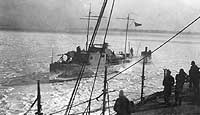 Accompanying
those freighters are several contemporary patrol vessels. Three
of a larger type were former fishermen: E.
Benson Dennis (SP-791), East
Hampton (SP-573) -- built in Maine, not Japan--, and San Juan (ID-1352).
Ex-pleasure craft include motor boats Eagle
(SP-145) -- later renamed SP-145 and Eaglet
(SP-909), and the schooner Eclipse
(SP-417).
Accompanying
those freighters are several contemporary patrol vessels. Three
of a larger type were former fishermen: E.
Benson Dennis (SP-791), East
Hampton (SP-573) -- built in Maine, not Japan--, and San Juan (ID-1352).
Ex-pleasure craft include motor boats Eagle
(SP-145) -- later renamed SP-145 and Eaglet
(SP-909), and the schooner Eclipse
(SP-417).
The "other" category concludes with two ill-fated amphibious
ships which were lost together, and share a pair of photos: LST-228 and LCT(6)-582;
the district craft YF-53
and YOG-56; and
the World War I era harbor vessels E.T.
Williams and Economy.
The last-cited two were ordered into World War I Naval service,
but apparently were not taken over.
Following a long break in preparing pages on such things, we
offer some foreign warships, among them the World War II Japanese
destroyer Yukikaze,
one of the very small number of that nation's modern "first
class" destroyers to survive the Second World War.
The others are presented as a puzzle for the pleasure of the Online
Library's patrons, and come with a little story:
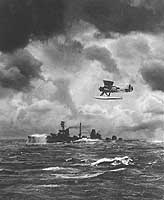 While
examining one of our more obscure collections, your scribe chanced
upon a nicely artful reproduction of a unique World War I era
battleship. (Just how "artful" would be discovered soon
enough, while trying to identify the nearby airplane). A junior
colleague was duly accosted and challenged to identify the ship,
which challenge was passed with flying colors. Basking in the
glory thus earned, said junior colleague laid hold of one even
more junior and reissued the challenge, along with the substantial
hint that the ship in question was well known to all who had enjoyed
a close association with Oscar Parkes' weighty battleship book.
When the victim of all this pleaded that he had enjoyed
a close association with Norman Friedman's battleship book, and
wasn't that sufficient, we assured him that Dr. Friedman, himself,
had most assuredly spent plenty of time in the company of Parkes'
tome, and that all right-thinking people should hasten to do the
same. Parkes, by the way, served in the ship in question. So,
dear patrons, we offer you an opportunity to gaze on the small
image at right and (purely for your own satisfaction, please --
no calls, no letters, no emails, no communications of any sort!),
contemplate all those center-line gun turrets and, having identified
the ship, go to the appropriate Online Library category and enjoy
the brand spanking new presentation we offer on it. By the way,
you will also find a second freshly-prepared page on this ship's
immediate predecessor of the same name, whose number of masts
was also pretty distinctive, if not precisely unique. For those
not wishing to subject themselves this little test, or who have
also been deficient in their attention to the works of Oscar Parkes,
all will be revealed in April's "What's New".
While
examining one of our more obscure collections, your scribe chanced
upon a nicely artful reproduction of a unique World War I era
battleship. (Just how "artful" would be discovered soon
enough, while trying to identify the nearby airplane). A junior
colleague was duly accosted and challenged to identify the ship,
which challenge was passed with flying colors. Basking in the
glory thus earned, said junior colleague laid hold of one even
more junior and reissued the challenge, along with the substantial
hint that the ship in question was well known to all who had enjoyed
a close association with Oscar Parkes' weighty battleship book.
When the victim of all this pleaded that he had enjoyed
a close association with Norman Friedman's battleship book, and
wasn't that sufficient, we assured him that Dr. Friedman, himself,
had most assuredly spent plenty of time in the company of Parkes'
tome, and that all right-thinking people should hasten to do the
same. Parkes, by the way, served in the ship in question. So,
dear patrons, we offer you an opportunity to gaze on the small
image at right and (purely for your own satisfaction, please --
no calls, no letters, no emails, no communications of any sort!),
contemplate all those center-line gun turrets and, having identified
the ship, go to the appropriate Online Library category and enjoy
the brand spanking new presentation we offer on it. By the way,
you will also find a second freshly-prepared page on this ship's
immediate predecessor of the same name, whose number of masts
was also pretty distinctive, if not precisely unique. For those
not wishing to subject themselves this little test, or who have
also been deficient in their attention to the works of Oscar Parkes,
all will be revealed in April's "What's New".
28 February 2006
 2006's
first big offering concerns Admiral Arleigh
A. Burke, who served an unsurpassed six years as Chief of
Naval Operations (1955-1961) and, in retirement, was a universally
respected figure who was, in essence, the Navy's "Grand Old
Man". Our presentation on Admiral Burke provides more than
a hundred images, selected from his vast collection and other
sources.
2006's
first big offering concerns Admiral Arleigh
A. Burke, who served an unsurpassed six years as Chief of
Naval Operations (1955-1961) and, in retirement, was a universally
respected figure who was, in essence, the Navy's "Grand Old
Man". Our presentation on Admiral Burke provides more than
a hundred images, selected from his vast collection and other
sources.
Beyond that we offer the usual increment of "new" old
ships: destroyers, submarines, transports and a bunch of others.
Leading off with "tin cans", the list includes Worden
(Destroyer # 16), Sterett
(Destroyer # 27), Aylwin
(Destroyer # 47), Rowan
(Destroyer # 64) and Harding
(Destroyer # 91). This group spans the first two decades of
U.S. Navy destroyer development, ranging from the Turn of the
Century's overgrown torpedo boats to the "flush-deck and
four pipe" ships spawned by the First World War.
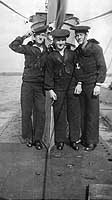 Newly-added
submarines cover a second two-decade period, ranging from just
prior to World War I to shortly before the outbreak of the second
global conflict. Included are the Simon Lake designed L-6
(Submarine # 45) and L-7
(Submarine # 46), O-7
(Submarine # 68) -- with many photographs of her 1918-era
crew members, R-4 (Submarine
# 81), S-7 (Submarine
# 112), S-8 (Submarine
# 113) and Seal
(SS-183).
Newly-added
submarines cover a second two-decade period, ranging from just
prior to World War I to shortly before the outbreak of the second
global conflict. Included are the Simon Lake designed L-6
(Submarine # 45) and L-7
(Submarine # 46), O-7
(Submarine # 68) -- with many photographs of her 1918-era
crew members, R-4 (Submarine
# 81), S-7 (Submarine
# 112), S-8 (Submarine
# 113) and Seal
(SS-183).
Moving on to transports, there are passenger-carrying ships of
both World Wars, the inter-war decades and the Cold War era. First
off is S.S. Antilles
of 1907, a civilian-operated ship that was torpedoed and sunk
while operating under U.S. Army charter in 1917. Her more fortunate
contemporary, and sister of the ill-fated USS President
Lincoln (introduced in late 2005 "What's New"
presentations), is USS President
Grant (ID # 3014). That ship not only survived World War
I, but, with a notably changed appearance, was the Army and Navy
transport (and, briefly, hospital ship) Republic
during the 1930s and 1940s.  Other
WW I era transports added in January include USS Great
Northern (ID # 4569), which was briefly the pioneering
fleet flagship Columbia
(AG-9) in 1921-1922 and also twice served as an Army
transport; USS Paysandu
(ID # 3880); USS Plattsburg
(ID # 1645), which was previously the long-serving commercial
passenger liner New York and the Spanish-American War U.S.
Navy cruiser Harvard; USS Wilhelmina
(ID # 2168); USS Zeelandia
(ID # 2507); and the coastal transport Yale
(ID # 1672). We conclude this extensive list of transports
with one, completed at the end World War II, which served actively
until the late 1960s and was not scrapped until the late 1990s,
USS Admiral Hugh Rodman
(AP-126). She spent most of her long career as the USAT General
Maurice Rose and USNS General Maurice Rose (T-AP-126).
Other
WW I era transports added in January include USS Great
Northern (ID # 4569), which was briefly the pioneering
fleet flagship Columbia
(AG-9) in 1921-1922 and also twice served as an Army
transport; USS Paysandu
(ID # 3880); USS Plattsburg
(ID # 1645), which was previously the long-serving commercial
passenger liner New York and the Spanish-American War U.S.
Navy cruiser Harvard; USS Wilhelmina
(ID # 2168); USS Zeelandia
(ID # 2507); and the coastal transport Yale
(ID # 1672). We conclude this extensive list of transports
with one, completed at the end World War II, which served actively
until the late 1960s and was not scrapped until the late 1990s,
USS Admiral Hugh Rodman
(AP-126). She spent most of her long career as the USAT General
Maurice Rose and USNS General Maurice Rose (T-AP-126).
There are seven new freighters and cargo ships, all of World
War I vintage, four of which served in the U.S. Navy. The latter
include two ex-Dutch freighers, Drechterland
(ID # 2793) and Dubhe
(ID # 2562), the last named only having a few days of commissioned
service; a former German steamship, Wabash
(ID # 1824); and the Sherman
(ID # 3345), which was named Durham for most of her
time in the Navy. Freighters which had no U.S. navy service were
S.S. Montanan,
torpedoed and sunk in August 1918; S.S. Deerfield;
and S.S. Aberdeen,
one of the many wooden-hulled ships produced in response to the
First World War's shipping emergency.  We
added five more tugs, among them Genesee
(SP-1116, later AT-55), which was scuttled to prevent capture
by the Japanese in May 1942; Dorothy
Cullen (ID # 2183); Dreadnaught
(ID # 1951, later YT-34 and YNG-21); Pentucket
(YT-8); and the World War II-built ATA-217,
which began construction as the net tender Tesota (YN-95,
later AN-71). Existing coverage of the harbor tug Penacook
(YT-6) gained a significant number of new photos and an expansion
of her history beyond the rather incomplete version previously
available.
We
added five more tugs, among them Genesee
(SP-1116, later AT-55), which was scuttled to prevent capture
by the Japanese in May 1942; Dorothy
Cullen (ID # 2183); Dreadnaught
(ID # 1951, later YT-34 and YNG-21); Pentucket
(YT-8); and the World War II-built ATA-217,
which began construction as the net tender Tesota (YN-95,
later AN-71). Existing coverage of the harbor tug Penacook
(YT-6) gained a significant number of new photos and an expansion
of her history beyond the rather incomplete version previously
available.
Our effort to provide coverage on World War I era converted yacht
patrol vessels is nearing an conclusion, with pages added on Vedette (SP-163); Venetia (SP-431); Winchester (SP-156),
a fast yacht that resembled a torpedo boat; and the unfortunate
Wakiva (SP-160),
sunk in collision with the already-mentioned USS Wabash.
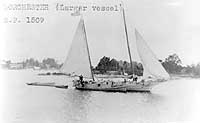 As
is often the case, there are scads of First World War motor boats
and other smaller types, the product of an alphabetically-driven
project to eventually post the available photography on all of
them (about which patience is recommended -- It's a looooong way
from "D" to "Z"!). This month's brood includes:
Dispatch (SP-973),
which had no Navy service; Doloma
(SP-1062); Dolphin
(SP-874), which was originally named Ora Belle; Dolphin (SP-318),
a "Menhadden Fisherman" type originally named Virginia
that the Navy appears not to have taken over; Dorchester
(ID # 1509), a Chesapeake Bay type sailing schooner; Doris
(ID # 1646), briefly chartered but probably not placed in
service; Dorothea II
(SP-912); Dorothy
(SP-1289); Dreadnought
(SP-584), a fast open craft of the "runabout" type;
and Drusilla (SP-372).
As
is often the case, there are scads of First World War motor boats
and other smaller types, the product of an alphabetically-driven
project to eventually post the available photography on all of
them (about which patience is recommended -- It's a looooong way
from "D" to "Z"!). This month's brood includes:
Dispatch (SP-973),
which had no Navy service; Doloma
(SP-1062); Dolphin
(SP-874), which was originally named Ora Belle; Dolphin (SP-318),
a "Menhadden Fisherman" type originally named Virginia
that the Navy appears not to have taken over; Dorchester
(ID # 1509), a Chesapeake Bay type sailing schooner; Doris
(ID # 1646), briefly chartered but probably not placed in
service; Dorothea II
(SP-912); Dorothy
(SP-1289); Dreadnought
(SP-584), a fast open craft of the "runabout" type;
and Drusilla (SP-372).
Finally, there are two barges, Dolphin
(ID # 1314), which was the Navy's Coal Barge # 518
and Duggan (ID #
3286), employed by the Navy as Car Float # 10.
In the midst of all these presentations created during January,
fresh images were added to several existing ones. The new pictures
on the WWI transport Powhatan
(ID # 3013) represents the largest single batch, but notable
individual items also joined the pages on the transports Buford
(ID # 3818), Harrisburg
(ID # 1663), Louisville
(ID # 1644) and Sierra
(ID # 1634); as well as those on the cargo ships Canibas
(ID # 3401) and Mexican
(ID # 1655).
31 January 2006
This page features the Online Library's 'What's New?' entries for January and February 2006.
For the more recent entries, and links to previous years'
entries, see:
| If you want higher resolution reproductions than the Online Library's digital images, see: How to Obtain Photographic Reproductions. |
Page made 6 July 2006